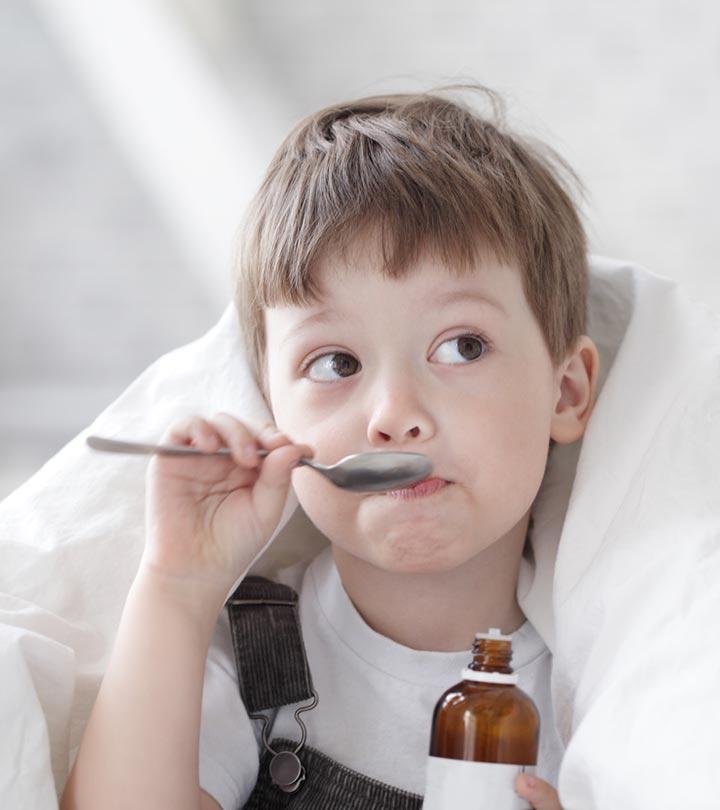
Image: Shutterstock
Children experience emotional outbursts and impulsiveness occasionally. But if that happens too often, it may be due to a borderline personality disorder (BPD). Borderline personality disorder in children is a mental health problem characterized by extreme emotions, impulsive behavior, emotional dysregulation, and severe problems with self-worth, which makes maintaining long, stable, and strong relations with others difficult (1). Most often, the signs and symptoms of BPD appear in childhood, but the condition becomes prominent only during teenage or adulthood.
Read on as we tell you about the signs, causes, diagnosis, and treatment of BPD in children.
Causes And Risk Factors Of BPD
The exact cause of BPD is unknown. Problems with chemicals in the brain responsible for mood regulation might trigger the development of BPD (1).
The following factors may put a child at a higher risk of developing BPD (2).
- It may run in the family.
- It is more common in children with a natural tendency to get upset easily.
- Growing in a household where children do not receive enough support and training to handle their big emotions.
Image: IStock
- It might be more common in children who might have experienced childhood trauma such as physical, emotional, or sexual abuse, neglect, or loss of a parent or had attachment difficulties with parents.
 Research finds
Research findsSymptoms Of BPD
Some mood swings and behavior changes are normal and happen with everyone. But for people with BPD, these problems are severe, repetitive, and may cause a disturbance with routine life. Some common symptoms of BPD include (1) (2).
- Intense emotions and mood swings
- Substance use
- Binge eating
Image: Shutterstock
- Spending a lot of money
- Trouble maintaining relationships
- Risky sexual behavior
- Behavioral issues
- Rash driving
- Low self-worth
- A severe feeling of being left alone
- Aggressive behavior
- May judge other people as only ‘good’ or ‘bad’ and no in-between. May also shift from one viewpoint to the other suddenly.
The following symptoms may also be seen-
- Feeling empty inside
- Anger issues
- Violent tantrums
- Self-harm
- Suicidal thoughts or attempts
- Episodes of paranoia
- Episodes of psychosis (inability to distinguish between real and imaginary)
- Brief but intense episodes of anxiety and depression
Complications Of BPD
People with BPD may also have other mental illnesses, such as depression, bipolar disorder, and attention-deficit hyperactivity disorder (ADHD), substance use disorder, or eating disorders. The children might have repeated emotional crises. They may develop promiscuous behavior as adolescents. Children with BPD may also have suicidal tendencies (2) (3).
Trishna Saikia, a blogger, shares about her Border Personality Disorder (BPD) and the complications it causes. She writes, “Being diagnosed with Borderline Personality Disorder has suddenly pushed me into a pool of déjà vu… I was scared. I cried for days. I asked my parents if they would abandon me too. And slowly as I learnt about the disorder all my actions started making sense for me… I am often surprised by how easily I get overwhelmed by the slightest of trigger. I do not have a handle on how I might react to a certain incident. Sorrow, anger, irritation and frustration are my best buddies. Something as simple as a taunt activates something painful inside. I never seem to forget that incident or forgive that person. I do not understand moderation, so any emotional expression is extremely intense and painful (i).”
Diagnosis Of BPD In Children
There are no specific blood tests or brain scans to diagnose bipolar disorder in children. However, the healthcare provider may advise these tests to rule out other conditions. A pediatrician and child psychologist will thoroughly analyze your child’s symptoms to arrive at a BPD diagnosis. To be diagnosed with BPD, the child must exhibit at least five of the symptoms mentioned above before reaching adolescence (2).
 Quick fact
Quick factTreatment Of BPD In Children
The treatment of BPD can be a little difficult, and it is not uncommon for the symptoms to return. Moreover, children with this psychological condition may also have disturbed relationships with their counselors and doctors. However, the treatment is long and eventually helps reduce the symptoms, avoid harmful behaviors, and help your children manage their emotions better. The treatment may include one or a combination of the following (1).
- Counseling and therapy
Image: IStock
A counselor plays a vital role in treating BPD in children. However, children with BPD may like their counselor one day and may hate them the other day. The children may develop more hatred for them, especially when the counselor asks them to change their behavior. A counselor specializing in dialectical behavior therapy (DBT) can be instrumental in treating this condition.
- Medications
Antidepressants, anti-anxiety medicines, mood stabilizers, and low-dose antipsychotics in combination with counseling and therapy can help treat BPD in children.
- Healthy habits
Sufficient sleep, healthy diet, regular exercise, and abstinence from drugs and alcohol can help reduce stress and anxiety. It reduces the frequency and intensity of symptoms of BPD in children.
 Point to consider
Point to considerWays That Help A Child Cope With BPD
The following tips may help you support your child with BPD.
- Be patient and non-judgmental.
- Promote a calm environment at home.
Image: Shutterstock
- Design strategies to control impulsivity.
- Help your child develop better interpersonal skills.
- Encourage your child to indulge in activities such as meditation, deep breathing, yoga, and relaxation techniques. You can do it with your child as a team.
- Exhibit and demonstrate love and support.
- Educate yourself about BPD.
- Lower your expectations and set realistic goals.
- Validate their emotions.
- Speak to the child honestly.
- It is difficult, but try not to lose your calm.
- Talk to them in clear, straightforward language. Also, be mindful of your nonverbal communication such as gestures, facial expressions, body language, etc.
- Be alert and aware of any signs of suicidal behavior.
- Make a daily schedule and stick to it.
- Encourage a healthy lifestyle and diet.
Image: IStock
- Be consistent with their appointments with the therapist.
- Ensure regular consumption of the prescribed medicines and no dose is missed.
- The school, teachers, coaches, and other caregivers should be informed and kept in the loop about the treatment. All of you should be on the same page regarding the child’s care.
- Talk about the child’s condition to their siblings and explain how they can help in empowering the child.
- If there are any other accompanying medical conditions such as a mental disorder, cardiac conditions, and learning disabilities, ensure they are monitored well and take all their medications properly.
- Keep an eye on any new and sudden changes in their dressing style, behavior, choice of friends, routine, etc.
Frequently Asked Questions
1. At what age does BPD develop?
According to experts, BPD can be diagnosed as early as 12 years if the child displays specific symptoms of BPD and the symptoms last for at least a year (4). However, in most cases, doctors don’t diagnose individuals under 18 years of age with BPD (5).
2. Does BPD ever go away?
BPD isn’t completely curable but is treatable. Research shows that symptoms of BPD reduce or reduce in intensity with age, and with proper treatment, several people see a marked improvement in their condition (6).
3. Are people with BPD aware of their behavior?
Yes, people with BPD are aware of their behavior and its consequences (7). Yet, they may behave erratically due to their fluctuating mood, emotional instability, or emotional sensitivity.
Borderline personality disorder in children may alter their routine and impact their social interactions and quality of life to a considerable extent. Although the condition can be treated, it may take time to spot noticeable improvement in your child. Therefore, it is essential to maintain patience and be determined to attain positive results following the treatment of BPD. Furthermore, for some parents, the diagnosis of BPD in a child could be overwhelming. You may seek help from online or local support groups in such scenarios. Consult your child’s doctor if you notice any abnormal behaviors (especially suicidal thoughts or attempts) in your children.
Infographic: Managing Borderline Personality Disorder
A child with borderline personality disorder may experience overwhelming emotions. Teaching them to manage their emotions will make them more aware of their condition and develop better coping skills. This infographic enlists some self-help techniques for children with borderline personality disorder. Illustration: Momjunction Design Team
Key Pointers
- Intense mood swings, binge-eating, and substance abuse could be signs of borderline personality disorder (BPD) in children.
- A psychologist may study the child’s behavioral patterns to diagnose BPD.
- The treatment may include medication, counseling, and lifestyle changes such as eating healthy food and exercising.
- To assist a child with BPD, be patient, talk to them in a straightforward manner, and be consistent with their appointments.
Image: Stable Diffusion/MomJunction Design Team
Watch this video through a mother’s eyes, offering a firsthand perspective on coping with a child diagnosed with Borderline Personality Disorder. Grasp insights into navigating emotions and fostering acceptance in the face of this mental health challenge.
Personal Experience: Source
MomJunction articles include first-hand experiences to provide you with better insights through real-life narratives. Here are the sources of personal accounts referenced in this article.
i. How I experience BPD ( Whether I deserve a badge of honour);https://saikia98trishna.medium.com/how-i-experience-bpd-whether-i-deserve-a-badge-of-honour-3c3c199b0fad
References
- Borderline Personality Disorder
https://www.mottchildren.org/health-library/ty6802 - Quick Guide to Borderline Personality Disorder
https://childmind.org/guide/quick-guide-borderline-personality-teens-young-adults/ - Childhood Disorder
https://www.momjunction.com/articles/childhood-disorders-types-causes-symptoms-treatment_00789762/ - Development and course of BPD.
https://www.borderlineintheact.org.au/living-with-bpd/development-and-course-of-bpd/ - Borderline Personality Disorder (BPD).
https://my.clevelandclinic.org/health/diseases/9762-borderline-personality-disorder-bpd - Borderline Personality Disorder.
https://www.health.harvard.edu/a_to_z/borderline-personality-disorder-a-to-z - Dorina Winter et al.; (2015); Can’t stand the look in the mirror? Self-awareness avoidance in borderline personality disorder.
https://bpded.biomedcentral.com/articles/10.1186/s40479-015-0034-9 - Wei-Hsin Lu et al.; (2017); Relationship between borderline personality symptoms and Internet addiction: The mediating effects of mental health problems.
https://pubmed.ncbi.nlm.nih.gov/28849668/ - Jean Marc Guilé et al.; (2018); Borderline personality disorder in adolescents: prevalence, diagnosis, and treatment strategies.
https://pubmed.ncbi.nlm.nih.gov/30538595/# - Understanding Borderline Personality Disorder in Teens.
https://www.mcleanhospital.org/essential/teens-bpd
Read full bio of Dr. Neha Bhave Salankar
Read full bio of Rebecca Malachi
Read full bio of Apoorva K


























